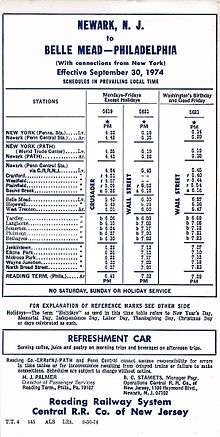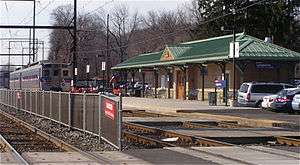West Trenton Line (SEPTA)
The West Trenton Line is a SEPTA Regional Rail line connecting Center City Philadelphia to West Trenton, New Jersey.
Route

The West Trenton Line connects Center City, Philadelphia with the West Trenton section of Ewing, New Jersey .The line splits from the SEPTA Main Line at Jenkintown, running northeast. At Bethayres, it crosses the Pennypack Trail that runs along the former Philadelphia, Newtown and New York Railroad, which once connected with the Fox Chase Line. At Oakford, the former New York Short Line Railroad, once part of the Reading's main line to West Trenton and Jersey City and currently CSX's Trenton Subdivision, merges. North of Oakford, the West Trenton Line follows CSX's Trenton Subdivision and track operations are controlled using CSX radio frequencies. The West Trenton Railroad Bridge, a concrete arch bridge, crosses the Delaware River to the final stop at West Trenton.
History

Like all of the Reading Company's commuter lines, the West Trenton Line was electrified in the early 1930s and has a mix of at-grade and grade separated crossings. Electrified service to West Trenton was opened on July 26, 1931. The RDG planned to also electrify tracks between West Trenton and the CNJ Terminal in Jersey City for long-distance service, but had to drop plans for electrification outside of the commuter service area due to economic setbacks as a result of the Great Depression.
The line north of the split at Jenkintown was originally built as the National Railway project, opened on May 1, 1876, to provide an alternate to the United New Jersey Railroad and Canal Companies' monopoly over Philadelphia-New York City travel. From Jenkintown to the Delaware River it was built by the North Pennsylvania Railroad as a branch, while the New Jersey section was built by the Delaware and Bound Brook Railroad, merging with the Central Railroad of New Jersey at Bound Brook. In addition to the Reading Company, which leased the North Pennsylvania Railroad in 1879, the Baltimore and Ohio Railroad also used the line for passenger and freight service to New York City, including its famed Royal Blue service. In 1976 the Reading merged into Conrail, and in 1983 SEPTA took over operations.
Prior to 1981, the line continued north to Newark, New Jersey (Jersey City prior to the Aldene Plan of the 1960s), using Budd Company-built Diesel multiple units. This service was originally launched by the Reading in 1937 under the name Crusader using streamlined steam locomotives and passenger cars. Currently, New Jersey Transit is looking at starting a commuter service between West Trenton and Newark, allowing an alternative to the SEPTA and NJ Transit service on the nearby Northeast Corridor line, as well as expanding rail service to currently unserved areas of Central New Jersey. SEPTA ended service beyond West Trenton on August 1, 1981.[2]
Beginning in 1984 the route was designated R1 West Trenton as part of SEPTA's diametrical reorganization of its lines. West Trenton Line trains operated through the city center to the Airport Line on the ex-Pennsylvania side of the system.[3] In later years this behavior changed; the line was designated R3 West Trenton and trains continued on to the Media/Elwyn Line on weekdays and the Airport Line on weekends.[4] The R-number naming system was dropped on July 25, 2010.[5] As of 2016, most West Trenton operate to Malvern on the Paoli/Thorndale Line.[6]
Stations

The West Trenton Line includes the following stations north of the Center City Commuter Connection; stations indicated with italics are closed. Weekday boardings are from FY 2013; data for stations between Temple University and Jenkintown–Wyncote include all lines serving those stations.[1]:95–96
| Zone | Milepost | Station | Boardings | City/Township | County | Connections |
|---|---|---|---|---|---|---|
| C | 2.1 | Temple University | 3,028 | Philadelphia | All SEPTA Regional Rail lines | |
| 1 | 5.1 | Wayne Junction | 527 | |||
| 7.3 | Fern Rock TC | 825 | ||||
| 2 | 8.4 | Melrose Park | 458 | Cheltenham | Montgomery | |
| 9.2 | Elkins Park | 632 | ||||
| 3 | 10.8 | Jenkintown-Wyncote | 1,998 | Cheltenham/Jenkintown | ||
| 12.0 | Noble | 222 | Abington Township | |||
| 12.8 | Rydal | 147 | ||||
| 13.8 | Meadowbrook | 141 | ||||
| 15.1 | Bethayres | 578 | Lower Moreland Township | |||
| 16.4 | Philmont | 633 | ||||
| 17.7 | Forest Hills | 434 | Philadelphia | |||
| 18.2 | Somerton | 676 | ||||
| 19.9 | Trevose | 283 | Bensalem Township | Bucks | ||
| 21.1 | Neshaminy Falls | 276 | ||||
| 4 | 23.9 | Langhorne | 643 | Penndel | ||
| 26.4 | Woodbourne | 702 | Middletown Township | |||
| 30.8 | Yardley | 392 | Yardley | |||
| NJ | 32.5 | West Trenton | 292 | Ewing | Mercer | |
Ridership
Between FY 2008–FY 2014 yearly ridership on the West Trenton Line held steady at 3.5 million.[1]:94[7][8][9][10][11][12]
References
- 1 2 3 "Fiscal Year 2016 Annual Service Plan" (PDF). SEPTA. June 2015. Retrieved August 13, 2016.
- ↑ Williams, Gerry (1998). Trains, Trolleys & Transit: A Guide to Philadelphia Area Rail Transit. Piscataway, NJ: Railpace Company. p. 71. ISBN 978-0-9621541-7-1. OCLC 43543368.
- ↑ Vuchic, Vukan; Kikuchi, Shinya (1984). General Operations Plan for the SEPTA Regional High Speed System. Philadelphia: SEPTA. pp. 2–8.
- ↑ "R3 West Trenton" (PDF). SEPTA. June 21, 2009. Archived from the original (PDF) on November 27, 2009. Retrieved August 20, 2016.
- ↑ Lustig, David (November 2010). "SEPTA makeover". Trains Magazine. Kalmbach Publishing: 26.
- ↑ "West Trenton Line" (PDF). SEPTA. July 11, 2016. Archived from the original (PDF) on August 7, 2016. Retrieved August 20, 2016.
- ↑ "Fiscal Year 2015 Annual Service Plan" (PDF). SEPTA. May 2014. p. 60. Retrieved August 13, 2016.
- ↑ "Fiscal Year 2014 Annual Service Plan" (PDF). SEPTA. May 2013. p. 44. Retrieved August 13, 2016.
- ↑ "Fiscal Year 2013 Annual Service Plan" (PDF). SEPTA. May 2012. p. 55. Retrieved August 13, 2016.
- ↑ "Fiscal Year 2012 Annual Service Plan" (PDF). SEPTA. July 2011. p. 94. Retrieved August 13, 2016.
- ↑ "Fiscal Year 2011 Annual Service Plan" (PDF). SEPTA. June 2010. p. 70. Retrieved August 13, 2016.
- ↑ "FY 2010 Annual Service Plan" (PDF). SEPTA. June 2009. p. 63. Retrieved August 13, 2016.
External links
| Wikimedia Commons has media related to West Trenton Line (SEPTA). |
- SEPTA – West Trenton line schedule (PDF)
- The Blue Comet - Reading Terminal to West Trenton, New Jersey






